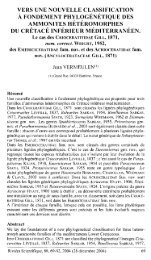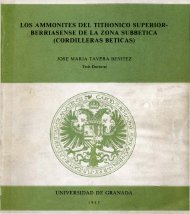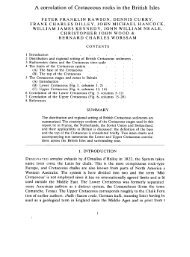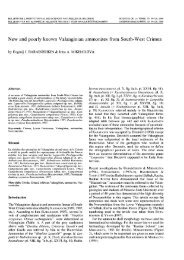thiolliericrinid crinoids from the lower cretaceous of crimea
thiolliericrinid crinoids from the lower cretaceous of crimea
thiolliericrinid crinoids from the lower cretaceous of crimea
You also want an ePaper? Increase the reach of your titles
YUMPU automatically turns print PDFs into web optimized ePapers that Google loves.
— 633 —gen. and Umbocrinus nov. gen. Each <strong>of</strong> <strong>the</strong>m is determinedby peculiarities <strong>of</strong> <strong>the</strong> calyx construction.However, <strong>the</strong>re are some species, belonging evidentlyto <strong>the</strong> family Thiolliericrinidae, for which only <strong>the</strong>columnals are known. These forms, mentionedusually under <strong>the</strong> generic name Apiocrinites or Bourgueticrinus,are placed below. Their taxonomic positionneeds a more accurate definition.hlajue <strong>of</strong> genus 3c P В Hr: Ht Bf :Lf Af°Solonaerium + - + 0,24 0,54 38T h io llie ric rin u s + + + С, 20 0,42 42Burdigalocrinus - + + 0,35 0,39 40Umbocrinus - + + 0,17 0,56 50L o rio lic rin u s - + + 0,35 0,57 37Oonoideocrinus - - + 0, bl 0,35 26H eberticrinus - - + 0,12 0,47 42Tabl. 2 — Main diagnostic features <strong>of</strong> <strong>the</strong> genera <strong>of</strong> <strong>the</strong> familyThiolliericrinidae. The designations (see fig. 2) : Sc - cirrussockets (yes - no), F - fossae on <strong>the</strong> centrodorsal (yes -no), В - basais (visible on <strong>the</strong> calyx surface or not visible),Hr :Ht - average relative height <strong>of</strong> <strong>the</strong> free radialsurface, Bf : Lf - average relative width <strong>of</strong> <strong>the</strong> radialfacet, Af° - average angle <strong>of</strong> <strong>the</strong> inclination <strong>of</strong> <strong>the</strong> radialfacet (in degrees).Caractères principaux de détermination des genres de lafamille Thiolliericrinidae. Légende (voir fig. 2) : Sczone d’insertion des cirres (présence - absence), F - fossessur la centr odor sale (présence - absence), В - basales(visibles sur la surface de la coupe dorsale ou non visibles),Hr : Ht - hauteur relative moyenne de la surfacelibre de la radiale, Bf : Lf - largeur relative moyenne dela facette radiale, Af° - angle moyen de l’inclinaison dela facette radiale (en degrés).Apiocrinites flexuosus G o l d f u s s (1826-1833, p.186, pl. 57, fig. 4) (= Bourgueticrinus flexuosusd ’ORBlGNY, 1840, p. 96-98, pl. 17, fig. 13-15) - Kimmeridgian<strong>of</strong> Germany (see also : Quenstedt 1852, p.612, pi. 53, fig. 17 ; 1876, p. 367, pi. 104, fig. 57, 58 ;Gislén 1924, p. 186).Bourgueticrinus oosteri D e L o r i o l (1879, p. 188,pi. 18, fig. 6,7) (= Bourgueticrinus flexuosus Ooste r , 1871, p. 130, 142, 149, pi. 19, fig. 1 and 23) -Lower Neocomian <strong>of</strong> Switzerland (see also : Rasmussen1961, p. 168).Bourgueticrinus sp. (Quenstedt 1876, p. 367, 431,pi. 106, fig. 43, 44) - Callovian <strong>of</strong> Germany.Bourgueticrinus sp. (Termier & Termier 1949, p. 57,86, pi. 6, fig. 8-14) - Upper Jurassic <strong>of</strong> Morocco (seealso : Ubaghs 1953, p. 716, fig. 101 and Müller 1963,p. 327, fig. 443 g ; 1978, p. 360, fig. 432 g - sub Balanocrinus,lapsus calami).Besides <strong>the</strong>se above mentioned species, <strong>the</strong>re is ano<strong>the</strong>rone which was placed by many authors in <strong>the</strong>family Thiolliericrinidae (De Loriol 1879, p. 195 ;1880, p. 11 ; 1889, p. 559 ; Carpenter 1884, p. 257 ;Gislén 1924, p. 186 ; Roux 1978a, p. 226 ; 1978b, p.A 21 ; Rasmussen 1978c, p. 879) - namely Bourgueticrinusoôliticus. The available morphological andgeological data (M’Coy 1848, p. 405 ; 1854, p. 53), inmy opinion, testify against that interpretation <strong>of</strong> <strong>the</strong>species.Upper Jurassic (Callovian) to Lower Cretaceous(Hauterivian) ; Portugal, France, Switzerland, Germany,Rumania, Czechoslovakia, Crimea, Caucasus,Pamyrs.Genus Solonaerium Étallo n, 1862 emend.Rasm ussen, 19781862 — Solonaerium Étallon (in Thurm ann &Étallon), p. 341 (errore typographico exSolanocrinus).1978c — Solonaerium Étallon : Rasmussen, p.881.Type species :Comatula sigillata Quenstedt, 1876.Diagnosis :Radiais have a high free external surface. Basais arevisible on <strong>the</strong> calyx surface. Cirrus sockets are <strong>of</strong> <strong>the</strong>same size in regular vertical rows. There are no fossaeunder radiais. Centrodorsal is high and conical. Stemfacet is small, deepened, pentangular or rounded.One species.Solonaerium sigillatum (Quenstedt, 1876, p. 176,pi. 96, fig. 49,50 sub Comatula ( = Solanocrinites costatusGo ldfuss, 1826-1833, p. 167 ex parte : pi. 50,fig. 2 ; non pi. 50, fig. 7 a,b = type specimen forSolanocrinites costatus ; nec fig. 7 c,d = Solanocrinitesorbignyi ; necdum fig. 7 a,f = ? Solanocrinitescostatus) (Solanocrinus costatus Étallon 1862, p.222 ; Solonaerium costatus Thurmann & Étallon1862, p. 341 ; Solanocrinus sigillatus Schliiter 1878,p .37 ; Comatula sigillata De Loriol 1879, p. 267 ;A ntedon sigillata Carpenter 1881a, p. 201, 202 ;Solonaerium costatum Rasmussen 1978c, p. 881, fig.588-3). Kimmeridgian ; Nat<strong>the</strong>im (Württemberg),Germany (fig. 3 A,B).Upper Jurassic (Kimmeridgian) ; Germany.
















